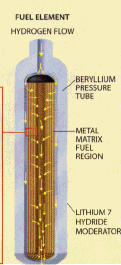

The way that fusion works is fairly simple, other than the fact that you need a spare nuclear fusion reactor. The problem is that fusion reactors currently can only sustain the fusion reaction for 1/10,000 of a second! So obviously this is a possible future technology. The way that all fusion reactors work is like this: 1) A fusion reactor has hydrogen diverted to flow through it superheating the gas to millions, or even billions of degrees! 2) The hot gas leaves the reactor, and is diverted twoards the nozzle. 3) The gas, which is flowing already at a rate of thousands of miles per hour due to the enormous pressure the million-billion degree hydrogen gas is creating, flows into a convergent nozzle, where it is compressed. 4) This compression raises the gas pressure to unthinkable amounts, and accelerates it to speeds many times that of a normal chemical rocket engine. This increased velocity provides as much an increase in thrust as in exhaust flow rate.
The advantages of this kind of fusion rocket are obvious, you take the rocket out of the earth's atmosphere, fire it up, and you have near light speeds! But it's not the best option, not by far. In fact the best option sounds like one out of not an old science fiction book today come true, but instead out of a science fiction book written today. This propulsion is the anti-matter drive, and it very well may be as far in the future as one might guess. This drive works just as simply as the fusion drive, only there isn't the complex part we lovingly call a "fusion reactor", instead, it's as simple as combining matter, and antimatter. When you combine the matter and antimatter, the cause a violent explosion. This explosion is contained by magnetic fields, and the energy is focused by a magnetic nozzle. This creates an un-believable amount of energy for how much fuel you use.
Yet, at the same time, it isn't so simple. There are problems too. One problem is that one-ten-thousandth of a gram of antimatter is made on earth per year. Then there's the fact that a kilogram of antimatter, mixed with a kilogram of matter, wil create enough energy to power all of the worlds electrical needs for a full half hour! Here's the problem, you have 1,000 tons of antimatter aboard your ship, and you must transport it 66 million miles, through meteors gas clouds, and even through the earth's atmosphere. When antiprotons touch protons (matter touching antimatter) they react with an enormous amount of energy. So, if a single proton gets through your magnetic containment fields, it all explodes when the initial explosion destroys the containment field. Yet, it is possible, and it has the advantages that 1,000% less fuel than a fusion reactor is required to get to our nearest star, and there's the fact that you could get all the closer to the speed of light.
Despite all of these obstacles, it is, like I said, possible to get to our nearest star. The problem is, we can only find out so much from our nearest brother, and these propulsions are designed to get a scientist to the nearest star in 40 years. That means that if we aren't content with Alpha Centauri, we can't do anything about it, not with any technology existing in the wildest dreams of the most far flung scientist in the world!
The ion drive
Fusion and antimatter drives
Light sails
Laser propelled light craft
Space Tethers
Ramjet/Scramjet engines
Other earth to orbit propulsion
Back to advanced propulsion main page
Home